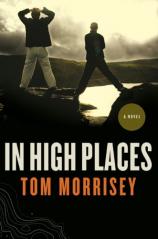In High Places
Review
In High Places
Tom Morrisey's best novel to date, IN HIGH PLACES, cost me a good night's sleep and a set of chewed-off fingernails. As a young boy's coming-of-age story, it is superb; as a suspense-filled cliffhanger (pardon the pun), it will keep you on the edge of your seat. I found I couldn't put it down until the very last page.
In several previous novels such as YUCATAN DEEP and DEEP BLUE, Morrisey (executive editor of Sport Diver magazine) took readers under the water in scuba thrillers. This time, he takes the adventures topside. Morrisey poignantly unfolds the first-person story of Patrick Nolan, a 16-year-old rock climber who returns from a father-and-son climbing trip to his home in Toledo to discover his mother's apparent suicide. Patrick and his dad leave Toledo to open a climbing shop in West Virginia, where Patrick must grow up fast in matters of family, faith and love.
Morrisey has always been a good adventure writer (his work has appeared in the adventurer's Bible --- Outside magazine --- as well as other publications). What sets this book apart from Morrisey's previous efforts is the appealing first-person point of view, strong, tight editing, refusal to succumb to clichés and lovely prose. His chapters begin and end so compellingly, you can't help but turn the pages.
The opening lines are especially beautiful, almost poetic:
"It was not the rock --- it was never the rock; it was the air. Air: gusts and threads of it, rustling my hair at the edge of my faded red rugby shirt collar. Air: swaying the thin red climbing rope that dropped beneath me in a single, brief, pendulous loop. Air all around me and above me and behind me, open and empty and unsubstantial, drying the sweat on my dread-paled, beardless face, an entire sea of air, an ocean of it, lying vacantly beneath my jutting, quaking heels."
If you're not a climber (like me) you'll struggle a bit with the plethora of gear, technical terms and climbing lingo. The epigrams of gear drawings and their uses at the beginning of each chapter lend insight, but most non-climbers will skim some of the climbing jargon as they read. For climbers, however, this might well be the meat of the book. Even non-climbers though will enjoy some of the catchy names of various rock face climbs ("Ye Gods and Little Fishes," "Thin Man") and glimpses into a world that us vertically-challenged folks may never explore.
One of the final and succinct but devastating scenes of the novel takes place at K2, a climbing venue I had just read about in detail in the fascinating THREE CUPS OF TEA. Morrisey's book will remind readers of a very abbreviated version of Jon Krakauer's INTO THIN AIR, with all the attendant disasters that climbing can bring.
I think I'd know a Morrisey novel anywhere by the inclusion of at least one character wearing Ray Bans (does he get endorsement credit for this from the company?), although he's much more restrained about brand names in this novel than in previous ones. Most impressively, Morrisey eschews the easy Christian fiction ending without eschewing faith. This is not one of those happily-ever-after tales; there are no assurances that right choices have been made. Unlike some previous books, where Morrisey tended to be a little preachy, he strikes a good balance of faith themes with reality. Choices, after all, have consequences. And there are regrets when we make the wrong ones and our lives turn out differently than we expected. But, as he writes in the final scene, "Sometimes, hope is all we have. And sometimes, hope is enough."
Morrisey has taken a giant step forward with this novel. I can't wait to see what he has next.
-
Reviewed by Cindy Crosby on November 13, 2011




